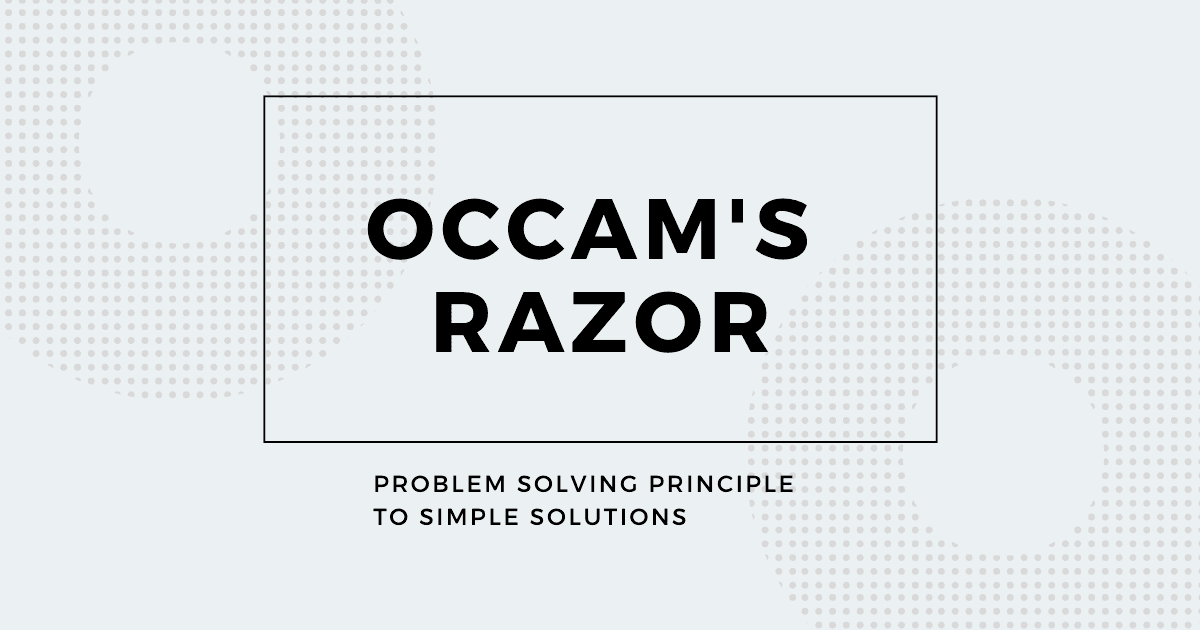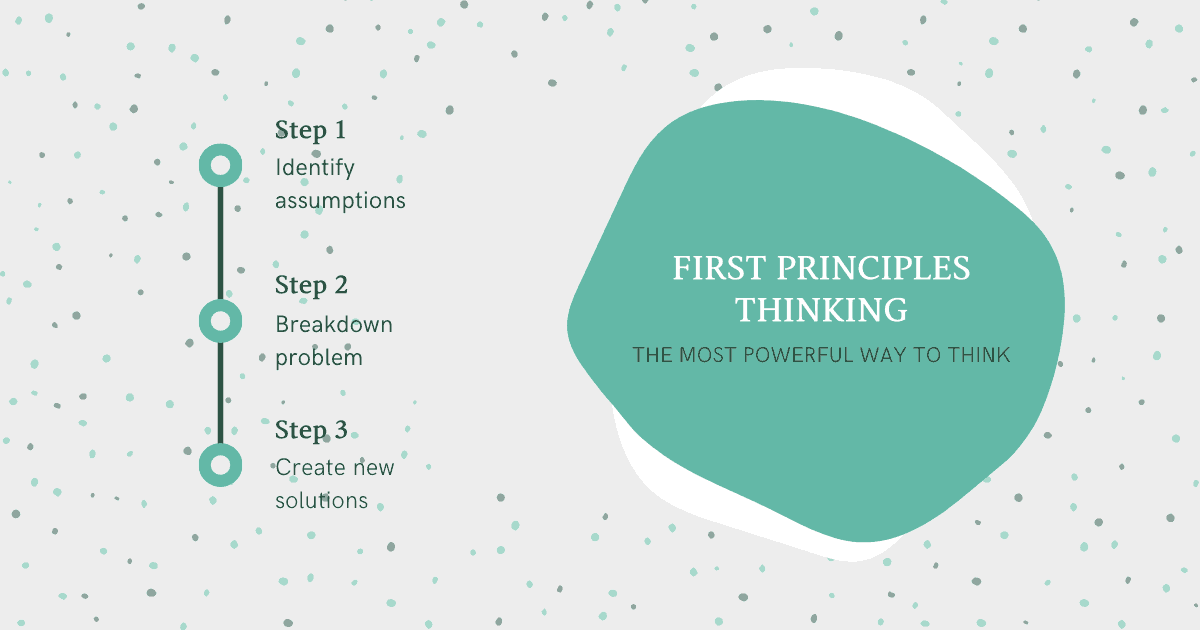Occam’s Razor: Problem Solving Principle To Create Simple Solutions

Occam’s razor (also called the law of parsimony) is one of the most useful mental models to solve problems. It advocates simplicity by focusing on key elements of the problem, eliminating improbable options and finding solutions with less assumptions.
In TV Show The Mentalist, Patrick Jane plays a game of heads and tails with his partner Wayne Rigsby and lands 20 consecutive heads to win the bet. While Wayne tries to uncover the mystery behind it, he wondered if Patrick rigged the coin, could he have the coin weighted on one side to always land heads or is there a specific technique to flip.
Later Patrick tells Wayne while cracking another case – Occam’s Razor says “The simplest solution to a problem is usually the correct one”. If you are wondering what Patrick did with the coin, you do not have to watch the whole series. You can just watch it below.
Occam’s razor principle has been used by scientists and philosophers for decades and is more relevant now than ever in the highly competitive, fast moving world with multiple technological advancements.
Simple does not mean ignoring important facts in an attempt to reduce the complexity. It requires open mindedness to seek a better solution with less complexity and less assumptions, exploring a better way of doing things.
Think how Google provides search, how Apple designs its products (iPhone and iPad). They shaved off complexity and un-useful information that does not add value to their users.
If google maps shows you two paths to the same destination with approximately the same distance and time where one path is more complicated than the other, which one will you choose. Simple, right?
Why keeping things simple makes business sense
Gaining new customers and keeping existing customers loyal to their brand is part of every organisation’s business strategy. Companies spend a huge amount of time and money in determining – what makes a customer choose one brand over the other. It’s called the “The Differentiating Factor”
Customers today are easily distracted due to cognitive overload and access to vast amounts of information available in their environment. Social media also plays a very important role in driving people’s decisions.
So, while social media and other marketing techniques can give the initial kick to make a customer land on your platform, it’s the value of your product and the simplicity of delivering it that will make a customer stick.
A painless experience across different touch points of a customer’s journey is what differentiates a company from its competition. We all know that anything painless cannot be complicated, it has to be simple.
While building a product, it’s easy to come up with a myriad of features in the assumption that they add value to the customer. In reality, they can be a source of distraction and reason for churn. Understanding what’s truly useful requires ripping off features, debating them and discarding the ones that do not deliver value and quality to customers.
For instance, for an e-commerce app, taking a share of customer’s time and money will require asking some of these questions:
“What are the barriers to enable a visitor to sign up? Do I really need all the information in the sign up process? What value does this information add to me and my customer?”
“How can I simplify all the steps in the customer’s purchase journey? Do I need all the steps? In each step, what information do I really need. How can I present useful information in the simplest possible way?”
“How can my customers reach out for help? Do they need to wait on hold every time they need support?”
Managing the entire customer experience by employing Occam’s razor philosophy can enable a business to shine and outlast its competition.
From Peter Drucker, one of the best and most widely known influential thinkers
Quality in a product or service is not what the supplier puts in. It is what the customer gets out and is willing to pay for. A product is not quality because it is hard to make and costs a lot of money, as manufacturers typically believe.
Mind Map Templates
Work through complex problems, identify correlations, and see the big picture using these mind map worksheets.
Why simple is hard

We know simplicity appeals. But do we really apply it in our work? Finding a cool solution to a problem is easy. But the real question is Is it really required?
We are driven by our intuition, which is a product of our experiences and how those experiences drive our actions. When solving a problem, we are influenced by the ideas that come easily to our mind (availability heuristic).
We then spin solutions that are congruent with these ideas and look for selective data that confirms our bias. Problems are complicated and finding simple solutions requires a conscious effort to dig deeper and give way to our creative mind. It requires avoiding these biases to cut through complexity and think solutions that do not require too much scaffolding to support.
Daniel Kahneman is a psychologist and economist notable for his work on the psychology of judgement, decision-making and behavioural economics. In his book Thinking Fast And Slow, he has demonstrated how availability heuristic plays a significant role in problem solving and decision making through multiple experiments.
Apply First Principles Thinking to break down the problem into its most essential elements before solving it. It provides a mental model to think and is considered one of the most powerful ways to think and solve problems.
While it may seem that simple is easy with less work, in reality finding simple solutions to problems require more work.
Cognitive Distortions Bundle
Challenge and replace irrational thoughts with more realistic and adaptive thoughts.
Examples of putting Occam’s razor in action
Let’s go through a few examples to understand how Occam’s razor philosophy plays a very important role at work:
Occam’s razor in development decisions
A developer can write both simple and complicated code to achieve the same outcome. However, it’s the code with simplicity that always stands out because it’s easier to read, easy to modify with less chances of an error and easy to review. Think of your code deployment process, code review process – can it be simplified?
Same applies to architecture and design choices. A complicated design with more assumptions is not only difficult to implement and test, but has more chances of failures and is less maintainable. A simple design that achieves the same outcomes will always be preferred over a more complicated version as it makes less assumptions.
While making a choice to use a particular technology, a developer may find multiple options that fit the criteria. It may be tempting to try new technology with no prior experience, but it’s more rational to use the one with in-house expertise and hence simple to use and apply.
Occam’s razor in interviews
For anyone who has been involved in interviewing, will you accept a candidate who presents a complicated solution to a problem where a simple one exists. Probably, yes. No solution is better than some solution, at least during an interview.
What if you provide multiple hints to reduce the complexity, but the interviewer does not pick up on your hints and sticks to the solution. Would you still hire the person? Probably not. Simplicity of solutions is a very important aspect that we all judge during interviews.
Occam’s razor to manage employees experience at work
Every company implements multiple processes to enable employees to do their best work and achieve success. The effectiveness of these processes require simple solutions that can be employed by a large group of people.
Managing employees experience requires taking a long hard look at each of these processes in your company and making an effort to simplify them:
“How do you plan and communicate goals with your team?”
“What’s the process to collaborate across different teams and functions?”
“How do team members manage their tasks?”
“What’s the process to measure outcomes?”
“How do you communicate feedback?”
“How do you manage poor performance?”
“What’s the process to celebrate and reward achievements?”
Occam’s razor principle serves as a logical tool to make simple decisions and choose simple solutions over complicated ones. Remember though, simple does not necessarily mean correct. It’s important to test and verify any solution against its original goals.
This is my second post on mental models. I will continue to write about other mental models to help you master them.
Do you prefer simple things in your work and life? Share your feedback in the comments below or write to me.






























Nice article…well written with good insight! Thanks
Thank you!!